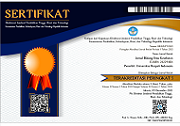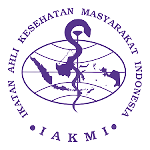- Focus and Scope
- Section Policies
- Peer Review Process
- Open Access Policy
- Archiving
- PULICATION ETHICS
- ARTICLE TEMPALTE
- AUTHOR FEES
Focus and Scope
Focus and Scope of the Journal, covering: Health Policy and Management, Nutrition, Nursing, Environmental Health, Epidemiology, Reproductive Health, Promotion of Occupational Health and Safety and Occupational Health.
Section Policies
Articles
Peer Review Process
Articles that have been sent to the journal will be reviewed related to the technical writing and substance of the article by at least 2 (two) reviewers.
Open Access Policy
This journal provides immediate open access to its content on the principle that making research freely available to the public supports a greater global exchange of knowledge.
Archiving
This journal utilizes the LOCKSS system to create a distributed archiving system among participating libraries and permits those libraries to create permanent archives of the journal for purposes of preservation and restoration. More...
PULICATION ETHICS
Publication Ethics
JBIK (Health Sciences Journal) (e-ISSN: 2622-948X) is a review journal published by the Institute for Research and Community Service of the University of Respati Indonesia. This statement explains the ethical behavior of all parties involved in the process of publishing an article in this journal, including the author, chief editor, Editorial Board, reviewer and publisher.
Ethics Guidelines for Journal Publication
The publication of an article in the JBIK journal reviewed is an important building in the development of a coherent and recognized network of knowledge. This is a direct reflection of the quality of the work of the authors and institutions that support them. The reviewed articles support and embody the scientific method. Therefore, it is important to agree on ethical standards that are expected for all parties involved in the act of publishing: writers, journal editors, best partners, publishers and the public.
The Institute for Research and Community Service of the University of Respati Indonesia as the publisher of the JBIK journal took on the task of maintaining all stages of publishing very seriously and we were aware of our ethics and other responsibilities. We are committed to ensuring that advertising, reprints or other commercial revenues do not affect or influence editorial decisions. In addition, the Institute for Research and Community Service of the University of Respati Indonesia and the Editorial Board will assist in communication with other journals and / or publishers if needed.
Publication Decision
The JBIK editor is responsible for deciding which articles to publish. Validation of the work and its importance for researchers and readers must always encourage that decision. Editors can be guided by policies from the journal editorial board and are limited by applicable legal provisions, such as defamation, copyright infringement and plagiarism. Editors can negotiate with other editors or best partners in making this decision.
Justice aspect
The editor evaluates the manuscript at any time to the intellectual content of the author regardless of race, gender, sexual orientation, religious beliefs, ethnicity, nationality, or political views of the authors.
Confidentiality
The editor and every editorial staff must not disclose any information about the manuscript sent to anyone other than the author, reviewer, prospective reviewer, other appropriate editorial board, and publisher, as appropriate.
Disclosure and Conflict of Interest
Materials that are not published in a submitted text may not be used in the editor's own research without the written consent of the author.
Task of Reviewer
Contributions to Editorial Decisions
Bestari partners help editors in making editorial decisions and can help writers improve the quality of the manuscript through the editor.
Speed
Each selected reviewer who feels he does not meet the requirements / interests to review the manuscript or does not have enough time to study must immediately notify the editor and withdraw from the review process.
Confidentiality
Each manuscript received for review must be treated as a confidential document. Manuscripts must not be disseminated or discussed with others unless permitted by the editor.
Standard of Objectivity
Review must be done objectively. Personal criticism from the author is not appropriate to convey. Reviewers must express their views clearly with supporting arguments.
Source Recognition
Reviewers must identify relevant published works that have not been quoted by the author. The statement that observations, derivations, or previously reported arguments must be accompanied by relevant citations. Reviewers must also state to the editor if there are substantial similarities or overlaps between the manuscripts considered and any other articles published.
Disclosure and Conflict of Interest
Information or ideas obtained in the review process must be kept confidential and not used for personal gain. Reviewers must reject texts where they have a conflict of interest due to competition, collaboration, or other relationships and connections with one of the authors, companies or institutions related to the manuscript.
Author's Duty
Reporting Standards
The author of the original research report must present an accurate report of the work carried out and objective discussion of the significance of the research. The underlying data must be included accurately in the manuscript. A manuscript must contain sufficient details and references to allow others to imitate work. Reports of fraud or deliberately giving inaccurate information are unethical and unacceptable behavior.
Data Access and Retention
The author is asked to provide raw data related to the manuscript for editorial, and must be prepared to provide public access to the data
ARTICLE TEMPALTE
WRITING GUIDELINES
JOURNAL OF HEALTH SCIENCE
The Health Sciences Journal accepts original scientific papers (articles, reviews / reviews, case study reports, book reviews, or matters relating to groups of health sciences. The article has not been published or is in the process of being submitted for publication in another journal or magazine.
PEER REVIEW ARTICLE
Articles that have been sent to the journal will be reviewed related to the technical writing and substance of the article by at least 2 (two) reviewers.
ORISINALITY AND PLAGIARISM
The author of the article must ensure that the manuscript sent is his own work and free of plagiarism. All the texts that will be published will be checked for similarity using antiplagiarism software.
1. Systematics of Writing
a. Initial section: title (maximum 20 words; 14 pt), author's name (without title), origin of institution / institution, email, abstract (written in Indonesian and / or English. Abstracts are arranged in words not exceeding 250 words using Calibri font size 11 pt single space. On the abstract page there are minimum keywords of 3 words and a maximum of 9 words.
b. The main part: contains the introduction, literature review and development of hypotheses (if any), methods / methods of research, results of research and discussion, and conclusions and suggestions.
c. The final part: thank you, symbol description (if any), and bibliography
2. Layout
Manuscripts are written on A4 paper with the margin format as follows:
a. Margin of 2.5 cm
b. Margins below 2.0 cm
c. Left margin 2.5 cm
d. Right margin of 2.0 cm
Each text has a maximum of 10 pages (including tables, images and reference lists) with a single spacing, Calibri font, size 11 pt.
b. Language, Unit and Symbol
Manuscripts written in Indonesian are standard, straightforward and clear. The use of units and symbols refers to the rules of the National Standards and International Units (SI).
Writing Equations
Equations or formulas are written using software equestion and are numbered, for example:
Ω = 2 πr ……………………………. (1)
Writing equations in text is stated by Press. (1).
Pictures and Tables
Images and Tables are printed in black and white. Writing pictures and tables like the example below.
Figure 1. Caption (below center) and Table 1. Description of the table (in the upper middle). In the text written in Fig. 1. and Table 1.
3. List of references
The reference list is written in the order in which it appears in the text using Vancouver Systems (numbers in square brackets). Reference includes initials and author's name (anonym), journal name or book name, volume, editor, publisher, city, year, and page.
Example Reference List:
Paper in the Journal
[1] E. Yusron. Jurnala Makara Sains 10, (2006) 41.
[2] G. Smith. Thin Solid Films (to be published).
Electronic Publication, Internet Information
[3] S. Auzary, K.F. Badawi, L. Bimbault. Phys. Rev. Lett. 68 (2008) 2912. Hep-th / 9112009.
[4] L. Weiss. Instruction to Authors, Elsevier Publishing, http: /www.elsevier.com/authors.html 1999.
Publication of Conference Proceedings
[5] C.H. Perry, F. Lu, F. Namavar, N.M. Accounting. Material Res. Soc. Symp. Proc. 256 (2005) 132.
[6] J.J. Favier, D. Camel. Proceedings of the Eight International Conference on Crystal Growth, York, U.K., 2006, p.58.
Monograph, edited book
[7] D. Falix [Ed.] Handbook of Optical Constants of Solid II, 3rd Ed., Academic Press, New York, 1991, p.253.
[8] S.M. Sze. The Physics of Semiconductor Devices, Wiley, New York, 1981, p. 345.
Thesis, Thesis, Dissertation
[9] R. Ramos. Ph.D. Thesis, College van Dean, University of Twente, Netherland, 1991.
[10] S. Badu. Undergraduate Thesis, Department of Chemistry FMIPA, University of Indonesia, 2008.
Patent
H. Yamagushi, A. Hiroe, H. Nishio. Japan Patent No. 5264701, November 23, 1993.
Industry Report Paper
[11] R.D. Nicholson. International Structures in Nickel-based Transitions After Long Term Service Joints, RD / M / N1131 Reports, Central Electricity Generating Board, Marckwood, 2005.
[12] J. Cleveland. Constant Spring Update, Digital Instrument, Santa Barbara, 1987. [If there is a Website address can be added with Italic letters]
Special Data [If the author is a team or synonym]
[13] Joint Committee on Powder Diffraction Standards, Powder Diffraction Files, ASTM, Philadelphia, 1967, Card 4301027.
[14] Anonymous. 19th Annual Book of ASTM Standards Part 17, ASTM Philadelphia, 1969, p. 457.
Unpublished results (referenced if necessary)
[15] D.H. Smith. Physics Department, Chicago University, Chicago, U.S.A., Private Commun, 1966.
[16] R. Stumpf, X. Gonze. Fritz-Haber Institute Research Report, 2006, Unpublished.
4. How to Submit Scripts
Manuscript sent to address:
Editorial Board of the Health Sciences Journal, University of Respati Indonesia (URINDO)
Jl. Bambu Apus I No. 3 Cipayung, East Jakarta.
Email: jbik@urindo.ac.id; lppm@urindo.ac.id
Online registration and submission: http://ejournal.urindo.ac.id/index.php/kesehatan
C.p: 08122504356; 089691155082
AUTHOR FEES
This journal charges the following author fees.
Article Submission: 0.00 (IDR)
Authors are required to pay Article Submission Fees as part of the submission process to contribute to review fees.
Fast Track Reviews: 0.00 (IDR)
With payment of these fees, reviews, editorial decisions and author's notices in this manuscript are guaranteed to take place within 4 weeks.
Publication Article: Rp 400.000 (IDR)
If the Writer wants a printed version, an additional fee of Rp 100.000 / Expansion (including post) is charged














